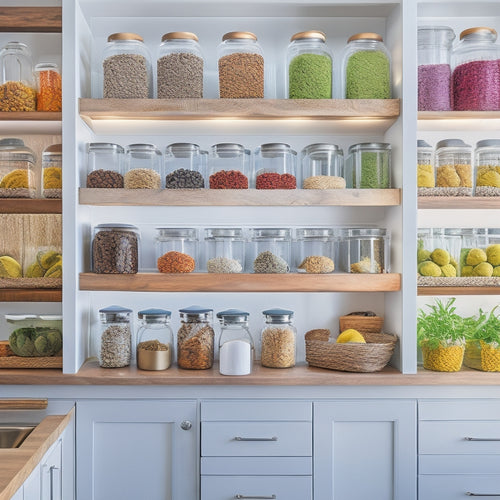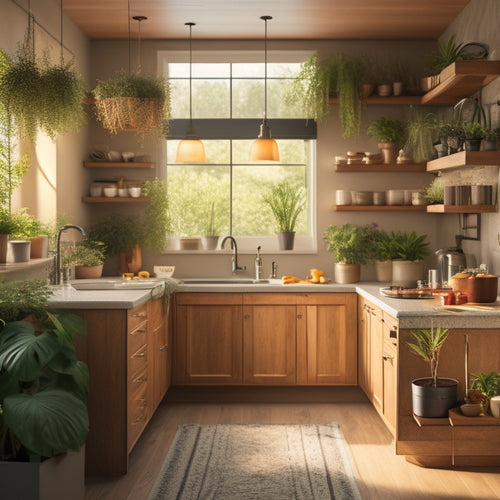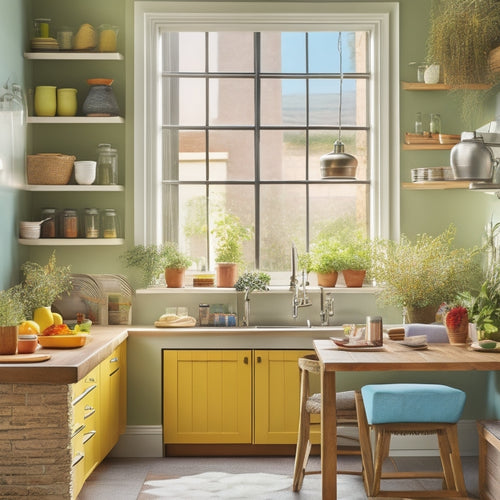
Why Is Decluttering Your Kitchen Pantry So Hard?
Share
You're struggling to declutter your kitchen pantry because it's a perfect storm of emotional attachment, storage challenges, and daily habits. You hold onto food items that evoke memories, struggle to part with inherited kitchen items, and fear wasting food and resources. Your pantry's design issues, lack of storage space, and overwhelming clutter causes stress and task paralysis. Busy schedules and unhealthy emotional eating habits don't help. Unrealistic expectations and fear of letting go of "perfectly good" items add to the challenge. Now that you know why decluttering is tough, let's explore the strategies to overcome these obstacles and create a functional pantry that works for you.
Key Takeaways
• Emotional attachment to kitchen items, especially inherited or gifted ones, makes it difficult to part with them, leading to clutter accumulation.
• Limited storage space and poor cabinet design can contribute to disorganization, making it harder to declutter and maintain a tidy pantry.
• Fear of wasting food and resources, as well as feelings of guilt, can cause people to hold onto expired or unnecessary items, perpetuating clutter.
• Busy schedules and poor time management lead to procrastination, making it challenging to dedicate time to decluttering and organizing the pantry.
• Unaddressed emotional eating habits, such as reaching for comfort foods, can hinder the decluttering process, making it essential to recognize and address these patterns.
Emotional Attachment to Food Items
As you stand in front of your pantry, you're likely to come face-to-face with food items that evoke memories, whether it's your grandmother's favorite cooking oil or the snacks you devoured during a memorable road trip. These items hold sentimental value, making it difficult to part with them. You might think, 'What if I need this someday?' or 'I can't get rid of this; it was a gift from my aunt.'
However, it's essential to recognize that holding onto these items can lead to clutter and disorganization.
To declutter your pantry, start by identifying the food items that hold emotional significance. Ask yourself, 'What memories do these items evoke?' and 'Is it worth keeping them?' Be honest with yourself, and consider taking a photo of the item or writing down the memory associated with it. This way, you'll preserve the memory without having to keep the physical item.
Lack of Storage Space Design
When you take a closer look at your pantry, you'll likely find that the shelves are too small, the cabinets are too shallow, and the corners are wasted space.
These design flaws can make it difficult to store your kitchen essentials efficiently, leading to clutter and disorganization.
Insufficient Shelf Size
You've likely encountered the frustration of inadequate shelf space in your kitchen pantry, where clutter accumulates due to insufficient storage capacity. This is often due to poorly designed shelf configurations, which can lead to wasted space and disorganization.
To maximize your shelf space, consider the following ideal dimensions for your pantry shelves:
| Shelf Type | Best Dimensions |
|---|---|
| Top Shelf | 12-18 inches deep, 36-48 inches wide |
| Middle Shelf | 12-15 inches deep, 30-42 inches wide |
| Bottom Shelf | 18-24 inches deep, 36-48 inches wide |
| Adjustable Shelf | 12-24 inches deep, 24-48 inches wide |
When designing your pantry shelves, keep in mind that you want to maximize vertical space while maintaining easy accessibility. Aim for a shelf configuration that allows you to store items of similar sizes and frequencies of use together. By optimizing your shelf dimensions and configuration, you can create a more efficient and organized pantry that makes meal prep and cooking a breeze.
Inadequate Cabinet Depth
Optimizing shelf dimensions is just the beginning; now it's time to tackle the issue of inadequate cabinet depth, which can render even the most well-designed shelves useless if you can't fit everything inside.
You may have ample shelf space, but if your cabinets are too shallow, you'll struggle to store bulkier items or larger containers. This limitation can force you to overcrowd your shelves or leave essential items out in the open, defeating the purpose of decluttering.
To overcome this challenge, consider cabinet reconfiguration. You can remove or adjust existing shelves to create more depth or install slide-out drawers to maximize storage capacity. Another solution is shelf extension, which involves adding extra layers or tiers to your existing shelves. This allows you to store more items while keeping them easily accessible.
Poor Corner Utilization
Designing your kitchen pantry's corners to maximize storage capacity is essential, as poor corner utilization can lead to wasted space and a cluttered kitchen. You're not alone if you've struggled with this issue. Many pantries suffer from corner wastes, where food and household items get lost in the dead space. This can lead to expired or spoiled food, not to mention the frustration of searching for items that are hard to reach.
Here are some common corner utilization challenges and potential solutions:
| Challenge | Solution |
|---|---|
| Hard-to-reach shelves | Install a lazy Susan or a carousel to make items more accessible |
| Wasted vertical space | Use stackable baskets or shelves to maximize storage |
| Cluttered corners | Implement a corner organizer system with bins and baskets |
| Inaccessible items | Incorporate a pull-out shelf or a sliding drawer to make items easier to reach |
Overwhelming Amount of Clutter
Clutter creeps into your kitchen pantry when food items, cookbooks, and gadgets accumulate uncontrollably, obscuring what you actually need and making meal prep a frustrating ordeal. This overwhelming amount of clutter can lead to clutter anxiety, causing you to feel stressed and overwhelmed every time you open the pantry door.
You're not alone; many people struggle to tackle this task. The sheer volume of items to sort through can be paralyzing, leading to task paralysis. You might think, 'Where do I even start?' or 'This is too much to handle.'
Take a deep breath and remember that decluttering your pantry is a process. Break it down into smaller tasks, like clearing one shelf at a time or sorting items into categories. Start by removing everything from the pantry and sorting items into 'keep,' 'donate,' and 'toss' piles. This will give you a sense of control and help you focus on what you really need.
No Clear Organization System
After you've purged your pantry of unwanted items, you're left with the task of organizing what's left, but without a clear system in place, you'll struggle to maintain your newly decluttered space.
A well-planned pantry layout is essential to keep your kitchen organized and functional. Without it, you'll find yourself back where you started - surrounded by clutter.
A system failure occurs when you don't have a logical and intentional way of storing and retrieving items. This leads to chaos, making it difficult to find what you need, and ultimately, causing you to waste time and energy.
To avoid this, take the time to design a pantry layout that makes sense for your needs. Consider categorizing items by type, frequency of use, and expiration date. Assign a home for each item, and make sure everything is easily accessible.
Fear of Wasting Food Resources
When you're hesitant to get rid of expired or near-expired food items, you're likely holding onto them out of fear of wasting money or resources. This fear can be overwhelming, leading to Food Guilt and Resource Anxiety. You might think, 'If I toss this, I'll be throwing away money and contributing to food waste.'
However, holding onto expired food can lead to more harm than good. Spoiled food can contaminate other items, causing more waste in the long run.
To overcome this fear, take a step back and assess the item's condition. Check the expiration date and the item's appearance. If it's past its prime, it's likely not safe to consume.
Consider donating unopened, non-perishable items to a local food bank or pantry. This way, you'll be reducing waste and helping those in need. By letting go of expired items, you'll create space for fresh, healthy foods and reduce your Resource Anxiety.
Difficulty Letting Go of Gifts
You may also struggle to part with food items given to you as gifts, even if they're not something you'd normally buy or use. This is often due to 'gift guilt' - the feeling that getting rid of a gift would be rude or ungrateful to the giver. However, holding onto these items can lead to clutter and disorganization in your pantry.
To overcome this hurdle, remind yourself that the giver's intention was to bring you joy, not to burden you with unwanted items. If you're not using the gift, it's likely not bringing you joy. Consider passing it along to someone who might appreciate it more. You can also take a photo of the item and thank the giver, allowing you to keep the memory without the physical clutter.
It's essential to separate the sentimental value from the practical value of the gift. Ask yourself if keeping the item truly honors the giver's intention or if it's simply taking up space. By letting go of gifts that no longer serve you, you're creating a more organized and functional pantry that allows you to better serve yourself and others.
Inherited Kitchen Items Sentiment
You've likely inherited kitchen items from family members or friends that hold sentimental value, making it tough to decide what to keep and what to let go of.
Grandma's antique teapot, for instance, may evoke fond memories, but it's taking up valuable space in your pantry.
It's essential to acknowledge the emotional attachment you have to these objects and consider how they align with your current kitchen needs and goals.
Grandma's Antique Teapot
Managing sentimental attachments to inherited kitchen items, like Grandma's antique teapot, can make decluttering a challenging task. You're not just deciding what to keep or discard; you're handling a web of emotions and family history.
This family heirloom holds sentimental value, reminding you of warm moments spent with loved ones. It's hard to imagine parting with something that brings back such fond memories.
However, it's crucial to separate the item's emotional significance from its practical usefulness. Ask yourself: when was the last time you used the teapot? Is it still functional, or has it become a decorative piece? Be honest about whether it's truly serving a purpose in your kitchen or if it's simply taking up space.
Consider displaying the teapot in a decorative cabinet or on a shelf, rather than keeping it in the pantry. This way, you can still appreciate its beauty and sentimental value without it cluttering your kitchen.
Emotional Attachment Objects
Inherited kitchen items, such as Grandma's antique teapot, often become emotional attachment objects that make decluttering a challenging task. You might be holding onto these items because they evoke memories of happy times, special occasions, or loved ones who've passed. It's crucial to acknowledge that they're not the memories themselves, just physical representations of them.
As you consider decluttering your kitchen pantry, remember that these items aren't just mere objects, but also:
-
Family heirlooms passed down through generations, carrying stories and history
-
Personal mementos that evoke feelings of nostalgia and warmth
-
Tangible connections to your heritage and cultural roots
- Symbols of love and care from those who came before you
Take a moment to reflect on why you're holding onto these items. Are you keeping them out of obligation, guilt, or genuine sentimental value? Be honest with yourself, and consider taking photos or creating a memory box to preserve the memories while letting go of the physical objects.
Busy Schedules and Procrastination
With demanding work hours, family responsibilities, and social commitments, it's no wonder that decluttering your kitchen pantry often takes a backseat to more pressing tasks.
You're not alone if you've been putting off this task, but it's essential to recognize that procrastination stems from poor time management and priority setting. You're busy, but that's not an excuse to let your pantry turn into a chaotic mess.
To overcome this hurdle, start by allocating a specific time slot for pantry decluttering. It might be 30 minutes on a Sunday afternoon or an hour on a Wednesday evening. Treat this time as non-negotiable, just like you'd any other important appointment.
Next, set clear priorities for your pantry organization project. What do you want to achieve? Do you want to free up space, reduce food waste, or create a more functional cooking environment? By setting specific goals and sticking to your schedule, you'll be more focused and motivated to tackle the task at hand.
Unhealthy Emotional Eating Habits
As you clear out your pantry, you'll likely uncover patterns of emotional eating that have driven your food choices.
You may notice that you tend to reach for certain comfort foods when you're stressed, bored, or feeling emotional.
Emotional Hunger Triggers
Recognize how emotional hunger triggers, such as boredom, anxiety, or stress, can hijack your best intentions and drive you to overeat or make unhealthy food choices.
You've probably experienced this before - you're feeling stressed, and suddenly you're craving comfort foods from your childhood. These emotional hunger triggers can be powerful, but acknowledging and addressing them is crucial to declutter your kitchen pantry effectively.
Think about the following scenarios:
** You're scrolling through social media during a break, and you come across a picture of your favorite childhood snack. Suddenly, you're craving it intensely.
**You're having a bad day, and you remember how your mom used to make you a warm, comforting bowl of soup when you were feeling down.
-
You're feeling anxious about an upcoming deadline, and you start thinking about the box of cookies you stashed away for 'emergencies.'
-
You're bored on a Sunday afternoon, and you start rummaging through your pantry for something to munch on.
These emotional hunger triggers can lead to unhealthy eating habits and clutter in your pantry. By recognizing and addressing these triggers, you can break free from unhealthy patterns and create a more balanced relationship with food.
Hidden Food Cravings
You've likely caught yourself reaching for specific foods when emotional hunger triggers kick in, but there are also hidden food cravings that can sneak up on you and sabotage your healthy eating goals. These cravings often stem from food memories, which can be powerful emotional triggers.
For instance, you might crave your grandmother's famous chocolate cake because it reminds you of happy family gatherings.
To overcome these hidden cravings, it's essential to identify the emotional connections you have with specific foods. Ask yourself, 'What am I really craving?' Is it the food itself or the emotional comfort it provides? Once you understand the underlying motivation, you can develop strategies to address the emotional need rather than relying on food.
For example, if you're prone to midnight snacking due to stress or boredom, try replacing the snacking habit with a relaxing activity, such as reading or taking a warm bath. By recognizing and addressing these hidden food cravings, you can break the unhealthy patterns and create a healthier relationship with food.
Unrealistic Expectations and Goals
Defining achievable objectives from the start is essential in order to avoid setting unrealistic expectations and goals for your pantry decluttering project, which can lead to frustration and abandonment.
You've likely seen those perfect images of organized pantries on social media or home decor websites, and you want your pantry to look just like that. But, let's be realistic, those images are often staged and edited to perfection.
You may be setting yourself up for disappointment if you aim for such high standards. Instead, focus on creating a functional and efficient pantry that works for you and your family.
Here are some common unrealistic expectations to avoid:
- Having a pantry that looks like a magazine cover
- Organizing your pantry in one day
- Getting rid of all unnecessary items without considering your family's needs
- Creating a system that requires constant maintenance and upkeep
Frequently Asked Questions
Can I Declutter My Pantry Without Getting Rid of Sentimental Items?
"You carefully consider cherished family heirlooms, acknowledging emotional attachments. Set aside sentimental items, then sort, categorize, and purge non-essential items, creating a curated space that honors memories while maintaining functionality."
How Do I Categorize Food Items That Serve Multiple Purposes?
You'll simplify categorization by grouping food hybrids, like tomato sauce for pasta and pizza, into multi-use categories, allowing you to store them logically and access them easily when serving others.
What's the Best Way to Store Snacks for Easy Access?
"Did you know 40% of Americans snack 2-3 times a day? You'll love creating Snack Stations with clear containers for easy visibility, making healthy choices a breeze for your family and guests, and keeping them coming back for more!"
Should I Organize My Pantry by Food Type or Expiration Date?
You'll find it's more efficient to organize your pantry by food type, creating pantry zones like baking, snacks, and meals, rather than by expiration date, allowing for easy food grouping and accessibility.
Can a Decluttered Pantry Really Save Me Money on Groceries?
You'll save money on groceries by reducing waste and making informed budget planning decisions with a decluttered pantry, allowing you to identify expired or surplus items, plan meals around what you have, and avoid duplicate purchases.
Related Posts
-

Innovative Lazy Susan Storage Solutions
Innovative Lazy Susan storage solutions are a revolutionary advancement for any space, especially in kitchens. They m...
-

Space-Saving Kitchen Island Storage Hacks
You can change your small kitchen into a functional haven with clever space-saving island storage hacks. Start by ins...
-

Creating More Space in a Tiny Kitchen
You can alter your tiny kitchen into a more spacious haven by utilizing smart storage solutions. Install wall-mounted...


